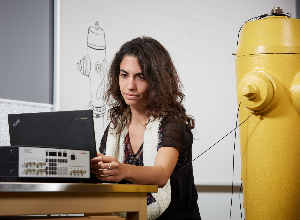 Tuesday, October 22, 2024
Tuesday, October 22, 2024  Tuesday, October 22, 2024
Tuesday, October 22, 2024 
Got news? Next submission deadline is Friday at 5:00 p.m.
Click here to submit YOUR news

Costly water losses in municipal water systems could be significantly reduced using sensors and new artificial intelligence (AI) technology.
Developed by researchers at the University of Waterloo in collaboration with industry partners, the technology has the potential to detect even small leaks in pipes.It combines sophisticated signal processing techniques and AI software to identify telltale signs of leaks carried via sound in water pipes.
The acoustic signatures are recorded by hydrophone sensors that can be easily and inexpensively installed in existing fire hydrants without excavation or taking them out of service.
“This would allow cities to use their resources for maintenance and repairs much more effectively,” said lead researcher Roya Cody, a civil engineering PhD candidate at Waterloo. “They could be more proactive as opposed to reactive.”
Municipal water systems in Canada lose an average of over 13 per cent of their clean water between treatment and delivery due to leaks, bursts and other issues. Countries with older infrastructure have even higher loss rates.
Major problems such as burst pipes are revealed by pressure changes, volume fluctuations or water simply bubbling to the surface, but small leaks often go undetected for years.
In addition to the economic costs of wasting treated water, chronic leaks can create health hazards, do damage to the foundations of structures and deteriorate over time.
“By catching small leaks early, we can prevent costly, destructive bursts later on,” said Cody.
Researchers are now doing field tests with the hydrant sensors after reliably detecting leaks as small as 17 litres a minute in the lab.
Keep reading this blog on the University of Waterloo website
Watch the video and learn more about the benefits of joining Construction Links Network – the peer-to-peer network sharing platform for the construction, building and design community.
Ideal for YOUR Press Releases | Project Updates | New Appointments | Awards & Milestones | Company News | New Products/Services | Brochures | Videos | Infographics | Blog Sharing | Events and More